In this article we will go over when to open a strong 1nt in bridge and most of the popular tools used after a 1nt opening in detail.
Shiang Chen, a seasoned professional bridge player will take you through the step-by-step process and gadgets of the 1NT opening, as well as provide quizzes to test your knowledge.
Here’s what you’ll learn:
The most popular treatment for 1NT is a balanced hand with 15-17 HCP, and that’s what I recommend for novice/beginner/intermediate players.
For more advanced players I will recommend 14-16 range instead. Especially for those that open light with most 11 counts and if their declarer play is good (can make game with 14 opposite 10 close to half the time).
Any decent 14 that has good play opposite decent 10 counts up to a bad 17 count.
The reason for this is it divides your opening ranges quite well:
- 11-13 as the min opener;
- 14-16 tries to open 1nt;
- 17/18 will invite 19+ will force to game.
Again, this assumes strong declarer play so you can make games with just 14 opposite 10 at least half the time, a beginner will generally struggle to pick up that extra trick using advanced play techniques.
Remember
Log on to BBO (Bridge Base Online), go to practice, then play some bridge master hands to hone your declarer play.
You should try to open 1nt as often as possible, especially if you have a decent 14, 15, or bad 16 count that’s not quite strong enough to invite on a 2nd bid, but can make game opposite 9/10/bad 11. That way you don’t miss game when partner has a decent hand but isn’t strong enough to invite.
It’s more important to not miss games than to play in the best partscore.
Here are a few of my best tips on the 1NT Bridge opening:
- DO NOT worry about stoppers
- Open 1nt with 5 card majors and balanced hands (5332 or 5422 shape)
- Open 1nt with 6 or even 7 card minors (7222 shape with AT LEAST Qx in all the other 3 suits) and balanced hands
- Singleton in a minor is fine usually 44(41) or 43(51) shape
- Singleton in a major should be an A so you can half tolerate a transfer bid
- Lean towards 1nt if your values are scattered (spread across different suits), lean towards not opening 1nt if your values are concentrated (all in 2 suits) like AKQx xx KQJxx xx, Best start this with 1d and try to re-bid 1s (pass if partner bids 1nt).
Here are a few examples that I recommend you to open:
- AKxxx Qxx Qxx Kx, open 1nt. If you end up in 3nt you want to protect your Qxx Qxx and Kx from the lead. You want to tell partner you have a lot more than a min opener of 11/12.
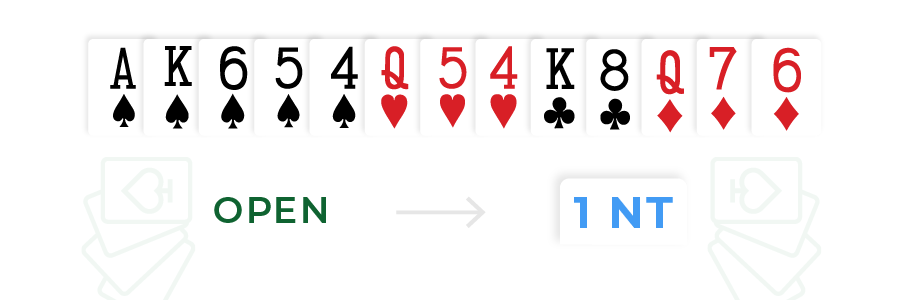
- KQxxx Kx KQxx Qx, open 1nt protect your Kx and Qx from the lead

- x KQxx KQxx KQxx, DO NOT open 1nt, you can’t tolerate a transfer to spades

- KQxx KQxx KQxx x, Open 1nt, singleton minors are fine
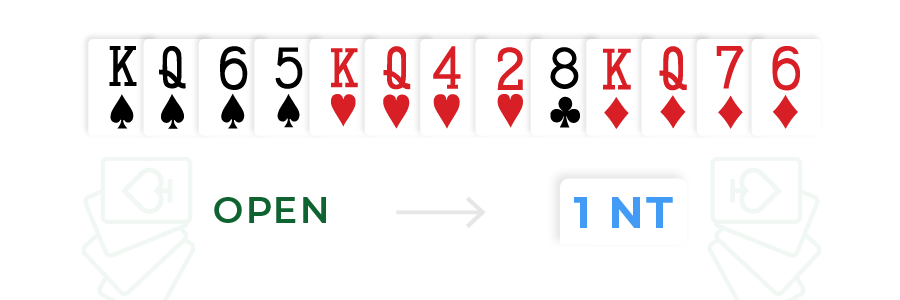
- A KQx QJ10xx Kxxx, Open 1nt, even though you have a singleton major it’s an A and you are semi-balanced.

Be aware
The problem with opening 1d is if partner re-bids 1s (most likely bid) you’ll have trouble describing your general balanced shape and your extra strength but not very strong.
If you re-bid 1nt partner will think you have 11-13. If you bid 2c partner will think you’re not balanced and still doesn’t know you have 15 HCP and not 11-13.
- Kx Kx KQJxxxx Kx, Open 1nt, you’re right on strength and protect your Kx’s from the lead.

- Kx xx AKQxxxx Kx, Open 1d then jump 3d on the next bid (even if partner bids 2c). Here your hand is a bit too strong for 1nt AND you do not have a heart stopper
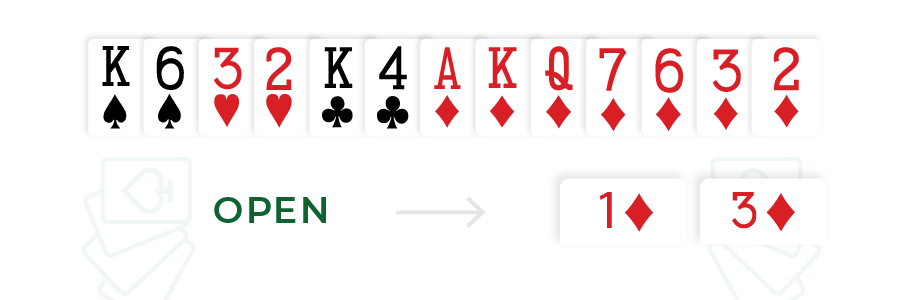
- Kx AK Qxxxx Kxxx, open 1nt
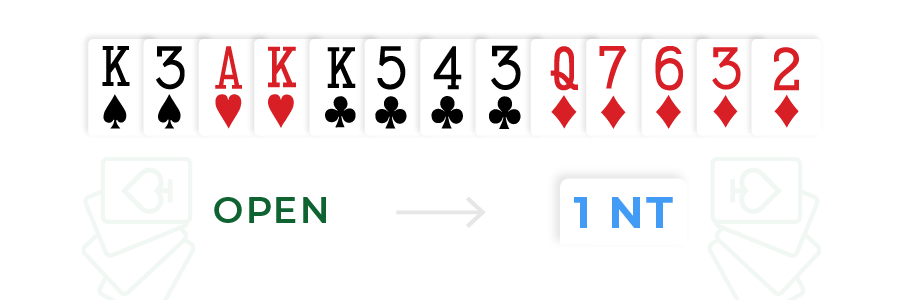
- xx xx AKxxx AKQx, DO NOT open 1nt. Your values are a bit too concentrated and you’re a bit strong open 1d then bid 2c.

- KQxx xx AKQx xxx, Open 1nt. While your values are concentrated, you are very balanced (4432 is the 2nd most balanced hand shape), almost always open 1nt with good 14 to bad 17 and 4333 or 4432 shape even if all the points are in 2 suits

- KQ109x Qxxx Kx Ax, This hand is borderline between 1s and 1nt, I would personally open 1nt but there’s nothing wrong with going with 1s
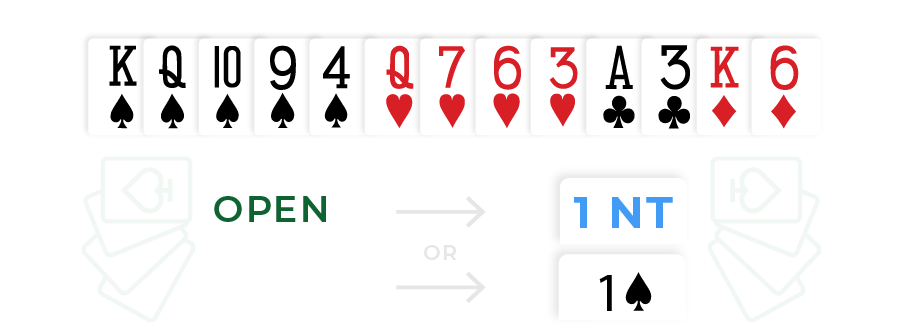
- AKQxx AKxx xx xx, Even though this hand has the right shape and HCP, it’s got both majors and concentrated values, this is a clear 1s opener and a 2h re-bid.
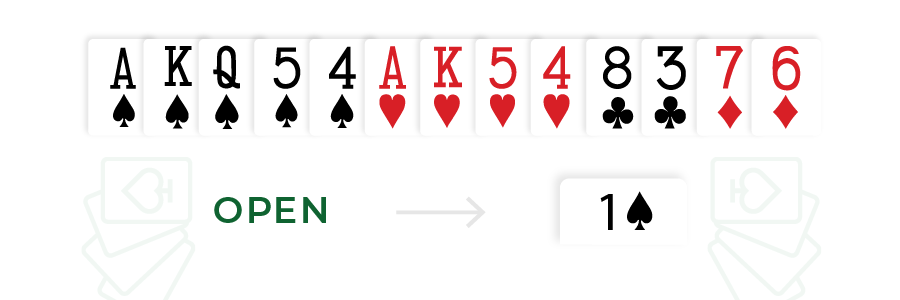
Keep in mind
It will be hard to tell partner that you have a good 16 HCP and not a 11-13 HCP and it’s possible he passes.
The solution to this problem is after 1s - 1nt - 2h responder should try to correct back to 2s even with 2 spades and 3 hearts and a mediocre hand 7-10 HCP to keep the auction alive so this hand can then bid 2nt to invite and show a 16/17 HCP hand.
- xx AKQx KQxxx xx Open 1nt, Plan ahead, if you open 1d you’ll struggle to bid again if partner bids 1s, a highly likely scenario.
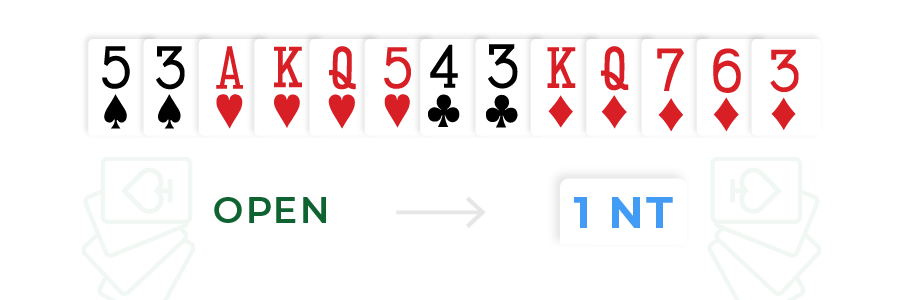
Pro tip
You’re not strong enough to reverse 2h and force to the 3 level, If you bid 1nt after opening 1d partner thinks you have 11-13, if you re-bid 2d partner will think you have a good 6 card suit and still doesn’t know you have extras.
While your values are concentrated, 1nt here is the lesser of two evils.
This is a very good 14 count and even playing 15-17 1nt it qualifies. HCP’s in long suits are worth more than HCP’s in short suits.
- AKQx xx KQJxx xx, because you’re values are very concentrated and you have a comfortable 1s re-bid over 1h here you should open 1d.
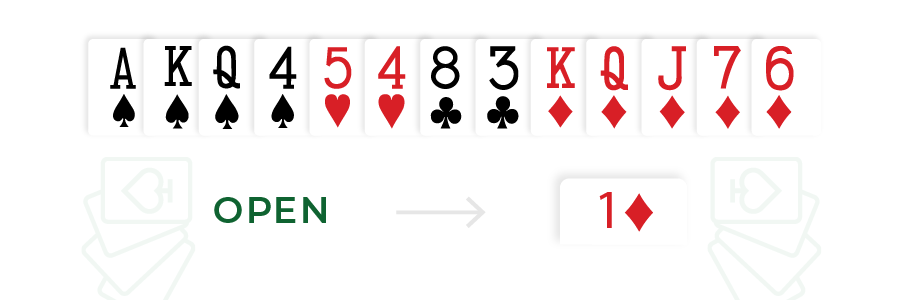
Pro tip
When you have spades and concentrated values you can re-bid 1s. When you don’t have spades then lean towards opening 1nt.
Open this one 1d, then bid 1s if possible.
If partner bids 1nt just pass, he doesn’t have 4 spades or 4 hearts and likely has a long club suit.
2d is ok too because you’re suit is good enough to play opposite a doubleton with KQJxx, with a worse 5 card suit say KJxxx don’t even think about re-bidding 2d.
Now that we have a pretty good idea of when to and when not to open 1NT(there’s some flexibility per partnership agreement), let’s go into depth on what to do afterwards.
Since the 1nt opener has shown most of his hand, he’s balanced/semi-balanced and has 15-17 or 14-16 depending on your agreement.
There’s not much to figure out.
The responders primary job is to show if he’s weak worth less than 9, invitational 9 HCP, or GF(game forcing) 10+, and to try to find out if there’s an 8 card major fit.
Author’s note
The following sections are intended for a wide audience ranging from beginner to advanced and will be subdivided into sections.
We will start with the easiest and most important conventions first and move to more complex and niche conventions as we progress.
If you’re new to bridge, don’t feel bad if you feel overwhelmed with the more advanced sections the new player and beginner tools will get you by most of the time.
If you’re more advanced feel free to skim the easier sections or jump straight to intermediate/advanced/expert.
To make things easier, we've included navigation for the upcoming sections. Pick what you want to learn:
New player
Beginner
Intermediate
Advanced
The 2 most important thing after partner opens 1nt is
- Find out if you have a game: Rule of thumb is 10 pts you go to game, 9 pts you invite. Obviously you can upgrade a little for some really nice suits and down grade for 4333 hands with lots of Q’s and J’s.
- Decide if it’s better to play in NT or in a suit, especially a major suit. Usually, if you have an 8 card major fit, it’s usually better to play in 4 of a major than 3nt.
There will obviously be exceptions such as both players being very balanced or have mirror distribution it’s often better to play 3nt than 4 of a major.
For now, as a new player, don’t worry about those exceptions, with game values 25+ total HCP play 3nt if you don’t have a 8 card major fit, play 4 of a major with an 8 card major fit.
The two most important conventions to play after partner opens 1nt are Staymen and Transfer, these will allow you guys to figure out if there’s an 8 card major fit.
One key thing to figure out is your side has an 8 card major fit after a 1nt opener.
Use 2c to ask if the 1nt opener has a 4 card major
The 1nt opener then bids 2d if doesn’t have a 4 card major, 2h if he has 4 hearts, 2s if he doesn’t have 4 hearts but does have 4 spades.
To bid stayman you must have at least an invite 9+ HCP AND a 4 card major
If opener doesn’t bid the major you like bid 2nt to invite with 9 HCP or 3nt to play 3nt with 10+.
One exception is if opener bids 2h over 2c you should show an invite with 4 spades by bidding 2s. If you have a game with 4 spades bid 3nt. Because you bid stayman first you must have 4 spades.
Let say your partner opens 1nt and you hold:J102 KQ432 QJ2 32.
What should we bid?
Here you have a nice 9 HCP hand, So not quite enough to play game opposite 15 but you want to play game opposite 16 or 17, so you want to invite partner, but you also want to show you have 5 hearts so you don’t miss a 5-3 heart fit.
If you play natural, where a suit bid shows the suit (other than 2c as that’s taken by staymen) you would have to jump 3h to invite. The problem with this structure is partner might have only 2 hearts and 15 HCP and you’re already too high, you’d rather play 2nt here not 3h.
Another problem arises if you’re even stronger and have a game, what now?
If you jump to 3nt you might miss a 5-3 heart fit, or even a 5-4 heart fit. If you jump 4h it’s even worse when you end up in a 5-2 heart fit. One solution is to play 3h as forcing to game but then you make the previous problem even worse as you have no way to invite.
There’s an elegant solution to this problem called transfer.
What you do is instead of bidding the suit directly you bid 1 step below it. So 2d shows 5 or more hearts, and 2h shows 5 or more spades. Partner is forced to take the transfer even with just 2 card support.
Remember
A 5-2 fit at the 2 level is perfectly fine, less so at the 3+ levels.
If you’re weak and have a 5 card major, transfer to your 5 card major then just pass. Simple enough.
A 5-2 fit at the 2 level typically has about the same chances as 1nt, usually slightly better when the 5 card suit is the weak hand.
A 5-3 fit would be much better so you have nothing to lose. Transfer even if you have zero points.
Now let’s go back and look at our example hand Jxx KQxxx QJx xx. Now what you can do is bid 2d after partner opens 1nt, he’s forced to bid 2h.
Notice because he was forced to bid, you are now guaranteed to have another bid as the auction is still alive so you get 2 bids to describe your hand instead of just one.
Now that you have already shown you have 5 hearts, you can invite with 2nt telling partner you have 5 hearts and an invite.
The opener can then decide if he wants to play 2nt, 3nt, 3h, or 4h. If you had a stronger hand then you can bid transfer then bid a 2nd suit at the 3 level or bid 3nt to show partner you guys have enough for game.
Following that logic what would 1nt - 2h - 2s - 3s mean? See if you can figure it out before reading on.
Well 2h means you have 5 or more spades. If you were weak you would just pass 2s. But the responder bid on to 3s.
He could’ve bid 2nt to show 5 spades and an invite so if he bids spades again he must have more!
Responder thus must have 6 (or more) spades and an invite, if he had 6 spades and game he would’ve bid 1nt - 2h - 2s - 4s instead.
Transfer is one of most useful bidding strategies, and can be used in a lot of other situations too so remember it well.
Quiz: Partner opens 1nt, Righty passes what should you bid with the following hands?
- Kx KQxx Qxxx xxx
- xx xxxxx xxx xxx
- KQxxx Qxx Qxx xx
- xx KQxxx Kxx Kxx
- xx KQxxx KQxx xx
- KQJxxx Qxx xx xx
- Kx J10xxxx Kx Kx
- Kx KQxx Qxxxx xx
Solutions:
1. You have 10 points partner has 15-17. 10+15 is plenty to bid game and hope for the best. But you shouldn’t just jump to 3nt you should first bid 2c to find out if partner has 4 hearts. So bid 2c stayman
2. You have zero points but you have 5 hearts, Maybe partner has 3 hearts and 2h would be better, maybe partner only has 2 hearts, bad luck oh well 2h will probably be no worse than 1nt.
3. Here you have a decent but not spectacular 9 count, bid 2h to transfer to 2s then bid 2nt to invite.
4. Here you clearly want to force to game with a pretty decent 11. But first bid 2d to transfer to then bid 3nt to let partner choose between 3nt and 4 hearts.
5. Like the last problem first bid 2d to transfer to 2h. But instead of 3nt here you have a better, more descriptive bid of 3.
6. First bid 2h to transfer to spades, obviously. You only have 8 HCP so normally it’s not an invite but the suit is amazing and your outside Q is at least in your longest side suit. You should bid 3s to invite partner and show him your 6 spades.
7. Bid 2d to transfer to 2h first. When in doubt just stick to basics and not out-smart yourself, Just bid 4h. Don’t down grade for honors being in the wrong place. Don’t try to pretend you only have 5 hearts. A 6 card major is almost always worth insisting on after partner opens 1nt.
8. This one’s tricky, If you can figure it out on your own without previous experience you have the makings of a good bridge bidder.
First start with 2c to see if partner has 4 hearts. If he shows hearts just jump to 4h. If partner bids 2s the best bid is 3d. Because you bid stayman first partner can figure out you have a 4 card major.
You didn’t support his spades, so you should have 4 hearts and likely a 5 card diamond suit. That’ll help him decide if 3nt is a good idea or maybe you guys should play 4-3 heart fit or 5d if you guys lack a club stopper.
Now, let’s explore gadgets that are suitable for beginners:
Now that we’ve learned transfers to majors, why stop there? We can transfer to the minors as well.
Use 2 spades to transfer to clubs, use 2nt to transfer to diamonds
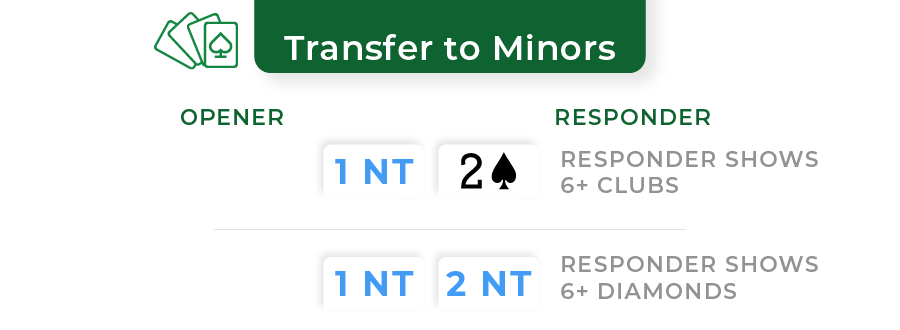
Please note
To do a invite without a 5 card major go through staymen first whether you have a 4 card major or not, if partner bids a matching 4 card major raise him to 3 of the major, if he doesn’t bid a matching 4 card major, bid 2s if he bids 2h and you have 4 spades, otherwise, bid 2nt)
But because partner has to bid the minor at the 3 level, minor transfers should show 6 card or longer suits.
So after 1nt:
- 2c - stayman, asking if opener has a 4 card major
- 2d - transfer to hearts, 5 or more hearts
- 2h - transfer to spades, 5 or more spades
- 2s - transfer to clubs, 6 or more clubs
- 2nt - transfer to diamonds, 6 or more diamonds
The astute reader will notice that after a minor transfer opener has two choices before reaching the minor contract.
You can choose the gap bid to show a good hand that is interested in playing 3nt if partner has a good suit.
- 1nt - 2s - 2nt - interested in 3nt opposite top 2 of 3 honors in clubs
- 1nt - 2s - 3c - not interested in 3nt opposite a weak transfer
- 1nt - 2nt - 3c - interested in 3nt opposite top 2 of 3 honors in diamonds
- 1nt - 2nt - 3d - not interested in 3nt opposite a weak transfer
Let’s say you open 1nt and partner bids 2s, a transfer to clubs. Which of the following hands should you supper accept with?
- Axx Axxx Axx Kxx
- Kxx AKxx AKxx xx
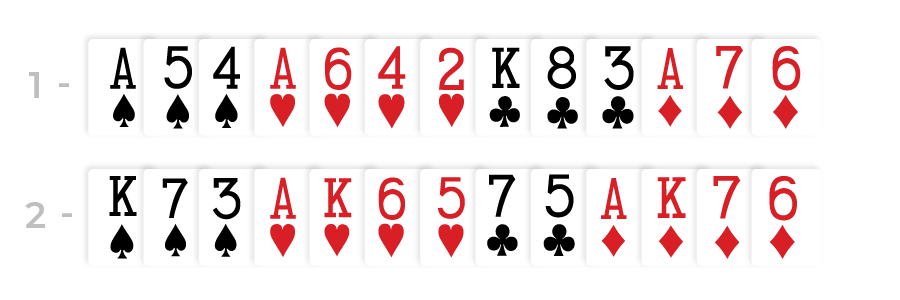
The first hand has only 15 HCP and very flat shape, the 2nd hand has 17 HCP and much better shape.
However you have to remember partner has 6 clubs. If partner has xx xxx xx AQxxxx, the first hand you have very likely 6 running club tricks, and 3 A’s for 9 total tricks.
The 2nd hand you have a lot of quick tricks of your own but partner’s clubs will be useless as there’s no entries to his clubs. Without the club tricks 3nt is hopeless. But if you play 3 clubs he can ruff all your losers so you should not invite to 3nt and play in 3c.
So you should actually supper accept with the first hand and NOT the 2nd.
Remember
To supper accept you should have some quick tricks and stoppers on the side and a GOOD trump fit with partner at least Hxx H = A, K, or Q. Partner should bid 3nt if he has top 2 of 3 honors, that way with the 3 top honors you can run the minor for 6 tricks in 3nt.
Everything is bigger in Texas, or so they say.
A Texas transfer is a jump to 4d or 4h after 1nt, showing you have a hand that wants to gamble on game or is serious about slam, and a 6 card suit.
- 1nt - 4d tells partner to bid 4 hearts, it shows 6 hearts and enough for game
- 1nt - 4h tells partner to bid 4 spades, it shows 6 or more spades and enough for game
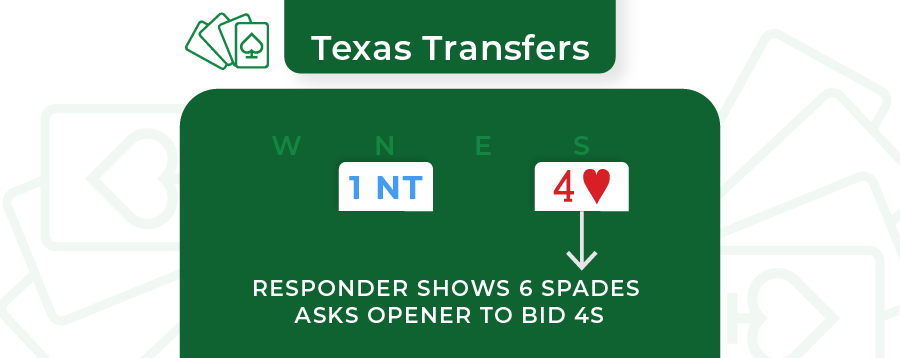
If you bid texas, you should either have either zero interest in slam or serious interest in slam (where you plan on using key card next)
Key card happens after a trump is set, here, because opener should normally have at least 2 cards in the majors and responder Texas transferred with 6 therEee should be an 8 card major fit. So now if you bid 4nt it asks for the number of key cards.
Pro tip
I personally recommend playing 1430 (It also happens to be the score you get if you play a vulnerable major slam making 6h/6s =). The key cards when there’s a suit contract are the 4 A’s and the K of trump.
After 4nt the responses are as follows:
- 5c - 1 or 4 key cards
- 5d - 3 or 0 key cards (14, then 30)
- 5h - 2 (or 5, almost never) key cards no Q of trump
- 5s - 2 (or 5, almost never) key cards yes Q of trump
After responding to 4nt key card if asker then again bids the lowest step that’s not the agreed suit he will be asking for the Q of trump if it’s not already known (for 1430 the Q is not yet shown).
If you have no Q of trump sign off in 5 of the agreed suit, If you have the Q of trump and a side K that you can bid below slam, bid the suit of the lowest side K.
If you have the Q but no king below slam you can bid then jump 6 of the agreed suit. If the Queen is already shown then just bid whatever side K’s you can afford to show without going over slam.
This agreement is called specific K’s.
Pro tip
If you have a little interest in slam and a 6 card major you should first do a normal 2 level transfer then jump to 4.
That shows better than a Texas transfer and a drop but only slightly interested in slam, generally was looking for a supper accept, we’ll discuss that in the intermediate section.
Quantitative is just a simple invite to slam opposite a 1nt opening. Generally, if you’re fairly balanced you need about 33 combined pts for slam. If either player has a good 5 card suit you need about 32 HCP.
If you have a 5 card major make sure to transfer first before bidding quantitative.
For grand slam you need about 37.
You bid quantitative by bidding 4nt after 1nt
How strong should you be to bid quantitative?
1nt range is 15-17, almost half the time partner will have 15 on a normal day but since you’re strong as well the odds of partner having only 15 goes WAY up.
So I’d say about half the time, maybe even more, partner will have only 15 HCP when you have a slam going hand. Hopping he has 17 when you’re already very strong is just wishful thinking. So you should want him to bid 6nt with 16 and pass with 15, give or take his own judgment.
Can you figure out what you should have to bid quantitative from the information given so far?
Well if you have a boring/bad 17, then if partner has a normal 15 you only have 32 and slam is questionable at best.
But if you have even a bad 17 and he has 16 you guys do have 33 and slam should be a favorite.
So you should invite with normal 17 counts.
You should also invite with good 16 counts that’s got a good 5 card suit as it’s worth a lot of tricks.
Very rarely will you ever be off exactly the 2 A’s with 32 HCP, it’s rare enough you shouldn’t have to worry about it. Any stronger than this and you should just bid 6nt (or different transfers and stayman first to check if it’s better to play in a fit)
There’s another invite called Grand slam force where instead of inviting to 6nt you’re inviting to 7nt. So for 7nt you need a total of 37 HCP.
After 1nt you bid 5nt to invite to 7nt.
So you need 21 HCP to make a grand slam force as 21+15 = 36, and 21+16 = 37, 22 HCP or better opposite 1nt opening just bid 7nt.

Remember
Bid 6nt even with a bad hand your partner is inviting you to 7 you want to at least bid your small slam.
There’s a reason I left gerber last, gerber is a way of asking for the number of A’s after a 1nt opening.
Since 1nt - 4nt is quantitative invite. To ask for number of A’s after 1nt you use 4c, as you don’t want to go over 4nt if you’re off more than 1 A.

Beginners love to use gerber and jump straight to Blackwood/Key Card instead of patiently showing their hands with forcing bids and discussing as much as possible before asking for A’s.
Asking for A’s or Key cards (A + K of trump if trump is set) should be one of the very LAST things you do, that’s like dotting your I’s and crossing your T’s.
Just one last check to make sure you’re not off 2 A’s and end up in a silly slam. By the time you bid gerber or key card you MUST be ready to bid slam if you’re off one key card, if that’s not the case, try to find another bid unless you’re truly out of options.
Better to first cue bid after finding a fit if you’re interested in slam, cue bidding is when you bid A’s, K’s, singletons, and voids on the side. This makes sure you don’t have 2 quick losers in any suits. If you have 2 quick losers in any suit then obviously slam is not possible no matter how good the rest of your hand is.
Take the follow hands for example:
- KJ KQJ97 KJ108 QJ
- AQ109 A108 AQ97 109

Here you have a good trump fit, 33 HCP, and all the 10’s and 9’s to boot, so if you’re not careful you’ll end up in a bad slam and lose 2 diamonds off the bat.
Let’s say south deals and opens 1nt with a good 16.
What NOT to do:
North might get impatient see’s he has a good 17 with lots of spots and jump 4nt invite. South with a good 16 of course bids 6nt and you now lose the first 5-6 (or more) diamond tricks. Not good, would be the understatement of the century.
Or
- 1nt - 4c (Gerber asking for A’s)
- 4d = 0 or 3
- 4h = 1 or 4
- 4s = 2 and minimum
- 4nt = 2 maximum
So south dutifully bids 4d for zero or 3 A’s. N can now see it must be 3 A’s because with no A’s south can’t possibly have enough pts for 1nt.
There’s only the Q of spades, Q of diamonds, and K of clubs out there so you can’t open 1nt with only 2 queens and one K.
North hearing 3 A’s decide to jump to 6nt, again losing 5+ diamonds.
What a good auction looks like:
- 1nt - 2d(transfer to hearts)
- 2h - 3d (natural and forcing to game)
- 3h (confirming an 8 card heart fit) - 3s (showing a first or 2nd round control in spades, A,K, singleton, or void, in this case because 3s was bid by the 1nt opener you know it’s almost certainly an A or K or both)
- 4d (showing first or 2nd round control in diamonds) - 4h
Despite having 17 HCP and having found a good heart fit, North does not even bother trying for slam, why?
Because south cue bid 4d and skipped 4c, If south had a club control he surely should’ve cue bid 4c instead of 4d.
Since S has no diamond control of his own and neither does north, there must be 2 diamond losers so there’s no point in bothering to look for slam.
So here’s the gerber convention in full, but remember to use it sparingly, better to use quantitative and certainly better to first use stayman and transfers first to look for fits.
After 1nt, a direct jump to 4c asks for number of A’s
- 4d = 0 or 3 A’s
- 4h = 1 or 4 A’s
- 4s = 2 A’s min HCP (bad 16 or less)
- 4nt = 2 A’s max HCP (decent 16 or more)
After 4d and 4h, the lowest bid should ask partner if he’s min or max.
- 1nt - 4c - 4d - 4h
- 1nt - 4c - 4h - 4s
If he’s min he bids 4nt. If he’s max he bids a suit to show a K in the suit bid.
After opener answers number of A’s, directly bidding 5c, then, asks for the number of kings.
Exact same answers only for number of K’s this time.
Now let’s explore some intermediate gadgets for the 1nt opening:
There’s a slight change/improvement you can make to the 2s club transfer. Instead of using 2s as strictly a transfer to clubs you can use it as something called clubs or size.
The way this works is 2s can be EITHER a club transfer with 6+ clubs, or a balanced invite without a 4 card major.
1nt opener bids 2nt with a min and 3c with a max.
If responder had the balanced invite he passes 2nt and bids 3nt over 3c.
Responder will pass 3c or correct 2nt to 3c with a bad club transfer.
If responder bids a new suit it’s confirmed to be a club transfer, but now it’s a game forcing hand.
For example
1nt - 2s (clubs or size)
2nt (min) - 3h (now it’s a strong hand with long clubs forcing to 3nt)
There’s generally 2 ways to play what a new suit means after a minor transfer.
Method 1
It shows a splinter, a singleton or a void in the suit bid. So 1nt opener can judge if that would be a problem in 3nt or maybe the splinter makes their hand really good and slam is possible, for example Ax xxx AKxxx KQx.
If the auction goes 1nt - 2s - 3c(max) - 3h(club transfer with heart splinter).
Now opener knows 3nt is a disaster but a club slam is very likely opposite 6 clubs, a good hand and a singleton heart, all you need is the K of spades, the A of clubs (which almost certainly is held by partner), and Either doubleton diamond or the Q of diamonds.
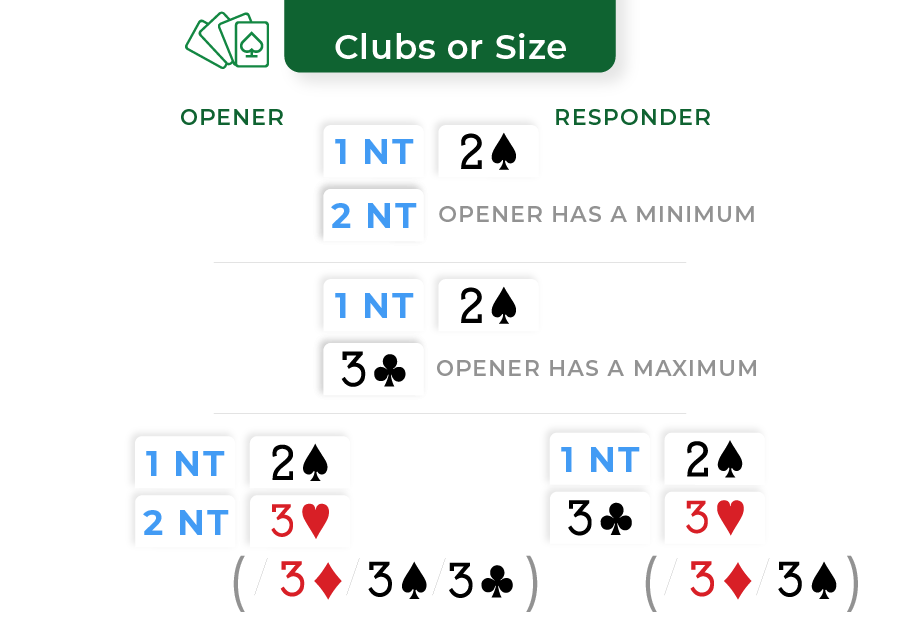
Method 2
A new suit is natural and generally shows a 4 card suit.
I find both methods perfectly good, you can try them out and see which one you like better. Method 1 tends to be more popular.
So if a partner makes this bid without discussion, I would generally assume it’s method one as that’s what the Robots on BBO play and is more popular.
The benefits of playing clubs or size is when you don’t have a 4 card major you generally want to keep things on a need to know basis and give less info to the opponents, why bother using stayman if you don’t really care about 4 card majors.
Another benefit is it make it harder for your opponents to show a major when you don’t have one, especially hearts. A 3rd benefit is when you do use stayman partner knows you have a major for sure.
For example
If the auction goes 1nt - 2c and the pesky opponents bid 2s. He can be pretty sure you have 4 hearts and double to check. If you have 4 spades pass and penalize 2s, if you have 4 hearts then you can bid 3h.
One draw back to clubs or size instead of a strict club transfer is you do lose the ability to supper accept. A small price to pay, and the benefits generally outweigh the downside.
Like the 2s bid there’s a small improvement for the 2nt bid after 1nt. You can play it as either a transfer to diamonds or both minors weak (usually 5-5).
Opener then bids the minor he prefers and pretends responder has weak minors.
If the responder happens to have diamonds and not minors weak, he just bids 3d to play or if he’s strong he bids a new major suit or 3nt, which confirms 6+ diamonds as he would not bid on if he had minors weak and would’ve just passed).
When 1nt opener picks diamonds over clubs that’s almost like a supper accept as his diamonds must be better than his clubs so he probably has something in diamonds.
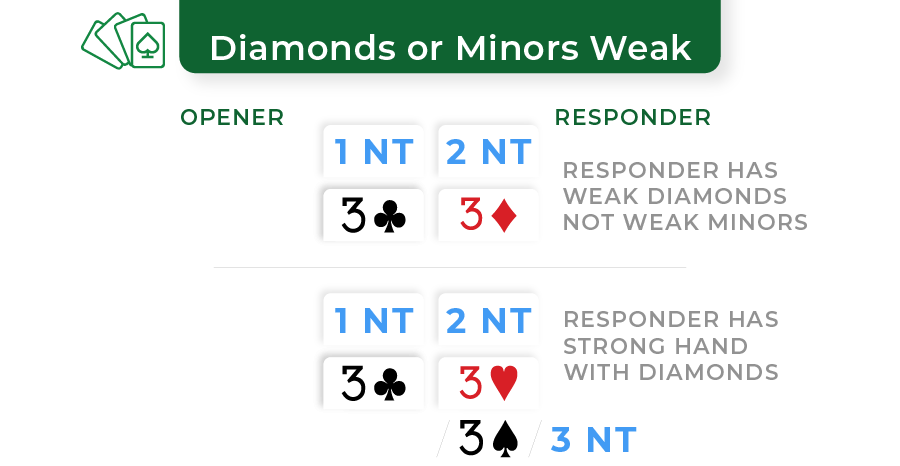
Read the Clubs or size section on the two possible treatments for bidding a major, for simplicity I recommend keeping the two the same.
So far in the New player and beginner sections we bid 2c stayman only with invite or better hands 9+ HCP.
However there’s another clever way to “fake” a stayman with a weak hand.
Your intentions might be to bid stayman and then just pass whatever partner bids instead of bidding on.
There’s actually 2 different uses of garbage stayman:
- You have 5+ diamonds, and 3+ in the majors, and short clubs (0 or 1). Your plan is to bid stayman and pass whatever partner bids.
- You have both majors and at least 9 of them (5-4 or more)

Here you bid 2c stayman if partner bids 2d you bid 2h showing a very weak hand with both majors and he can pick his better major.
If he bids a major you’re thrilled and obviously pass.
When you have a 5 card major you’re supposed to transfer, when you have a 4 card major you’re supposed to use stayman.
So what do you do if you have both a 5, and a 4 card major?
Here’s what I recommend: If you have enough for game, 10+ HCP or even slam going hands, you can use the smolen convention.
With a 5 and a 4 card major you should first use stayman, if partner bids a major great, bid game in that major or if you want to try for slam bid 3 of the other major (see below for Goldman slam tries, or check out reverse BAZE in the advanced section for even better treatments).
If instead, partner bids 2d denying a 4 card major you then jump to 3 of your 4 card major, NOT your 5 card major to show 5-4.
Why jump the 4 card major and not the 5 card major you might ask.
The reason is who would you usually rather play the hand the 1nt opener or the responder?
The answer is usually you want the stronger hand to be protected from the lead and hidden. So the responder jumps in the major they would not play in so if there’s a 5-3 fit in the other major the opener will be the first to bid that suit and declare the hand.
- 1nt - 2c - 2d - 3h (this shows 5 spades and 4 hearts and enough for game)
- 1nt - 2c - 2d - 3s (this shows 4 spades and 5 hearts enough for game)
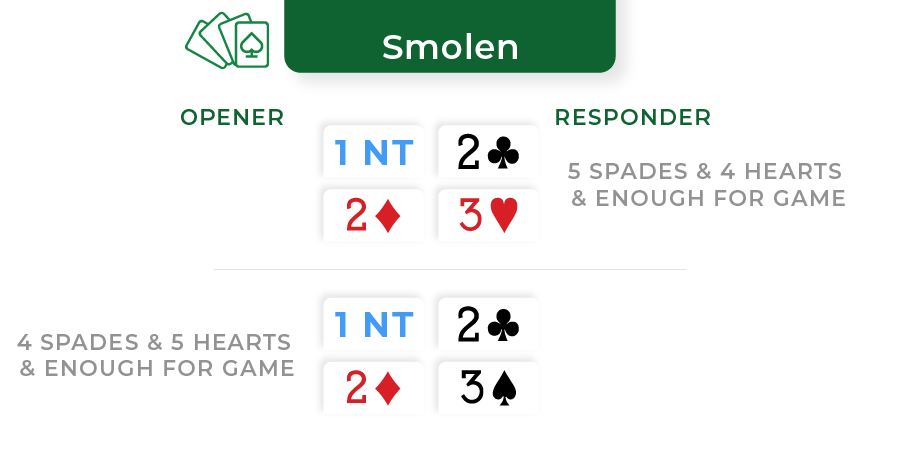
Ok great so we now know how to bid strong hands with 5-4 in the majors, what about invitational hands.
Here’s what I would suggest:
With 5 spades and 4 hearts and a hand that wants to invite. First bid stayman then if partner bids a major, raise him to 3 of the major and invite. If partner partner bids 2d denying a major bid 2s, this shows 5s 4h.
Here you don’t have the luxury of bidding the other major to right-side the contract; it’s not a huge deal. At this point, opener should bid whatever contract he wishes to play in or pass 2s.
With 5 hearts and 4 spades and a hand that wants to invite. First transfer to hearts, then bid 2s:
- 1nt - 2d - 2h - 2s (this shows 5 hearts 4 spades and an invite)
- 1nt - 2c - 2d - 2s (this shows 5 spades 4 hearts and an invite)
If you’re weak with 5-4 major what should you do?
If you remember from above under garbage stayman we can show weak hands with both majors by bidding: 1nt - 2c - 2d - 2h
When you have 2 fits, a 4-4 fit and a 5-3 fit, or a 4-4 fit and a 6-2 fit it’s usually better to actually play in the 4-4 fit.
That’s because if the 4-4 fit is trumps you can draw 3 rounds of trumps, then use your long suit in the other fit to pitch all the losers in the last 2 suits and cross ruff the rest.
If you use the long suit as trumps then the 4-4 fit can’t pitch anything in the other 2 suits.
So far above we have covered how to show 5-4 in the majors of all different strengths.
But how do we show 6-4 in the majors?
The answer is it’s not so different from 5-4. First we start with stayman if we find a fit great, jump to game or make a slam try and agree to the suit (see goldman slam try below, or reverse BAZE in the advanced section)
If partner bids 2d then jump to 4d or 4h to texas transfer. This is called a delayed texas transfer and shows 6-4 in the majors.
- 1nt - 2c - 2d - 4d (shows 6 hearts and 4 spades)
- 1nt - 2c - 2d - 4h (shows 6 spades and 4 hearts)

When partner shows a 4 card major agree to it by bidding game or make a slam try, do not show the 6 card major to your opponents.
Delayed texas is for if you have game values. If you want to just invite then transfer to your 6 card suit then raise to 3, you won’t have the luxury of showing 4 cards in the other major.
If you’re very weak with 6-4 in the majors just transfer to the 6 card suit and pass, rather rare, when you’re 6-4 you usually want to invite or game force even without a lot of HCP’s.
Like 6/7 HCP in the long suits is often plenty to invite, that 6-4 shape is worth a lot, 2-3 HCP’s at least.
So far here’s all the bids we’ve used:
- 1nt - 2c stayman
- 1nt - 2d transfer to hearts
- 1nt - 2h transfer to spades
- 1nt - 2s clubs or size
- 1nt - 2nt diamonds or minors weak
- 1nt - 3nt is “to play”
- 1nt - 4c is gerber
- 1nt - 4d is texas transfer to hearts
- 1nt - 4h is texas transfer to spades
- 1nt - 4s (we have not discussed this bid, see 2 way quantitative/grand-slam force in the advanced section)
- 1nt - 4nt quantitative invite
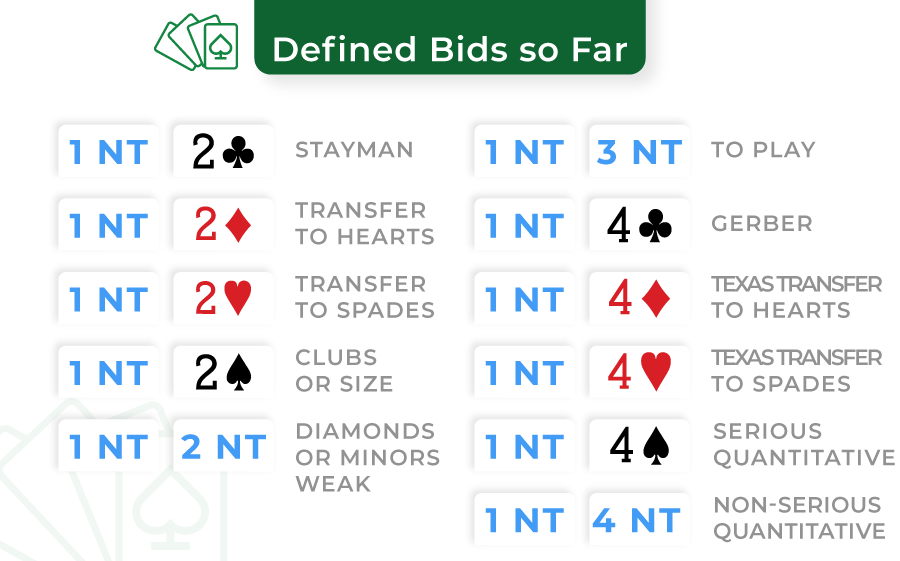
As far as I know, I don’t know of any good uses for bids at the 5 level, perhaps exclusion Blackwood (A ask with a void in the suit bid telling them to not cout the A in the void suit)?
6/7 level bids are generally used as “to play”, though almost never used as usually you want to just texas and ask about A’s.
Still, sometimes for tactical reasons you want to hogg the hand and play the contract instead of letting the 1nt opener play the contract.
So notice that we have not gone over what most of the 3 level bids mean.
There are several ways to play it, one easy and popular treatment is for the 3 level bids to all show 5-5:
- 3c is 5-5 minor invite
- 3d is 5-5 minor GF
- 3h is 5-5 Major invite
- 3s is 5-5 Major GF
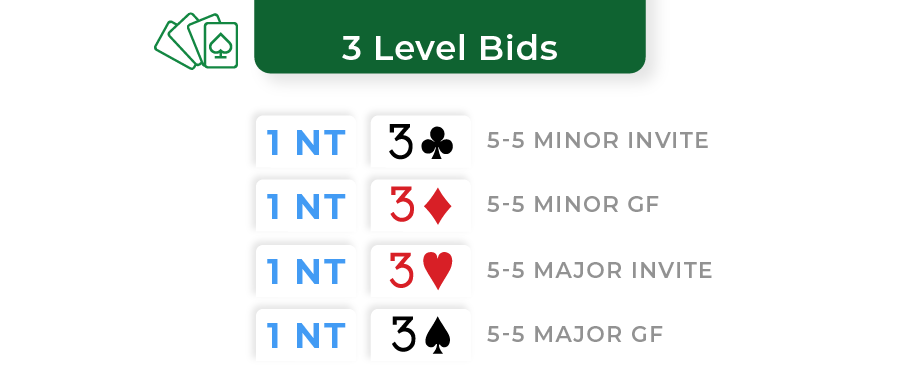
Goldman slam try is after a stayman sequence and opener bids a 4 card major. 3 of the other major is showing a fit in the major bid and shows slam interest.
Usually after that, both players will cue bid 1st and 2nd round controls (A, K, singleton, void) then decide if they want to key card for slam.
- 1nt - 2c - 2h - 3s, shows slam interest with heart fit
- 1nt - 2c - 2s - 3h, shows slam interest with spade fit
- 1nt - 2c - 2h - jump to new suit shows a splinter (a fit and a singleton in the suit bid)
- 1nt - 2c - 2s - jump to a new suit shows a splinter (a fit and a singleton in the suit bid)

For example
1nt - 2c - 2s - 4d (shows a spade fit, a singleton diamond, and interested in slam)
There’s a slightly better treatment called reverse BAZE in the advanced section.
After a transfer to a major, if you have a good 16 or 17 and 4 trumps for your partner you can do something called supper accept.
That way if partner has a good 6, 7, or 8 HCP but not enough to invite you won’t miss a game.
- 1nt - 2d - 3h
- 1nt - 2h - 3s
This comes naturally to most players as they play more bridge.
However, notice that there are lots of bids in between that aren’t used.
You can use those to show doubleton supper accepts, which shows a doubleton with no wasted value (not Qx) in the suit bid. Then responder can re-transfer you.
- 1nt - 2d - 2s (doubleton spade) - 3d (re-transfer) - 3h
- 1nt - 2d - 3c - 3d - 3h
1nt - 3d - 3d, here you lose the ability to re-transfer as the 3d bid is taken now the contract is wrong sided if responder wants to stay at the 3 level, responder will now have to bid 3h.
Another problem is if you bid your doubleton it makes it easier for your opponents to double the bid to try to compete with you in case there’s a big fit.
It would be a lot riskier for them to actually bid the suit instead of just doubling it.
Here’s a solution I came up with:
Instead of bidding the doubleton directly, bid the suit under the doubleton, and do a loop going up.
1nt - 2d (transfer to hearts) - ?
- 2h - accept transfer, normal
- 2s - doubleton in club (Ax Kx, or xx no wasted value)
- 2nt - doubleton in diamond
- 3c - doubleton spade
1nt - 2h (transfer to spades) - ?
- 2s - accept transfer, normal
- 2nt - doubleton club
- 3c - doubleton diamond
- 3d - doubleton heart
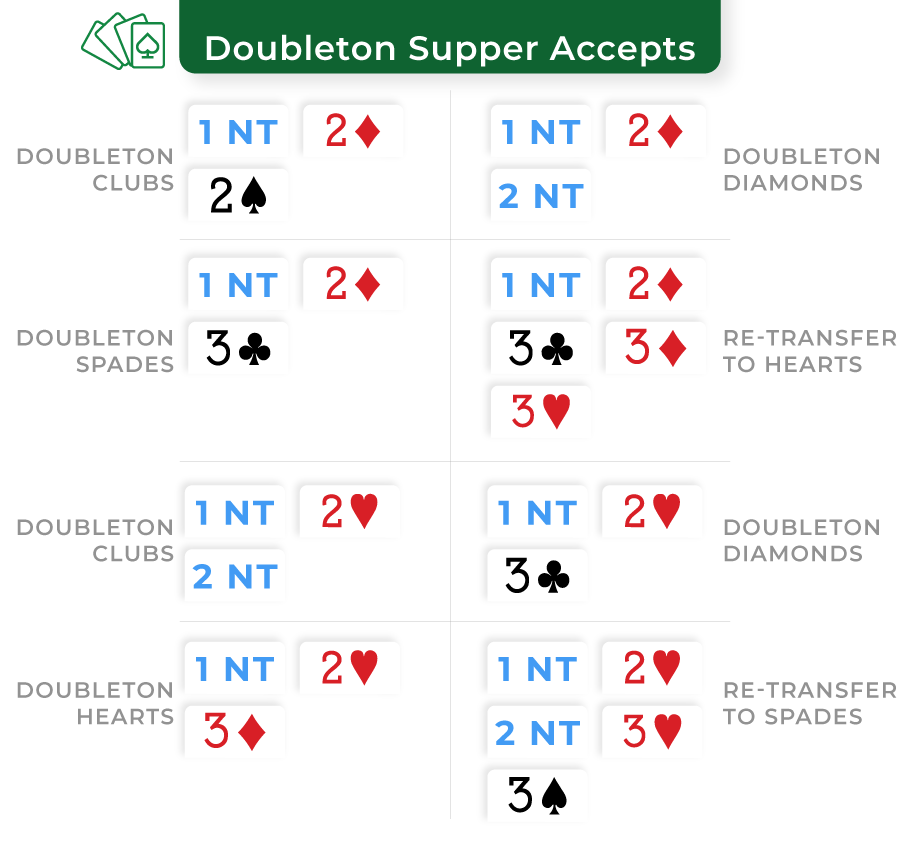
Notice you can show every side doubleton and still have room for responder to bid re-transfer, 3d for hearts, 3h for spades.
Also, you never directly bid you’re doubleton so it’s harder for them to show a suit by simply doubling.
Now if they want to show a long suit they have to actually bid it and risk getting doubled themselves vs a strong NT.
If you like opening 5 card majors a lot, even with slightly unbalanced hands I highly recommend you switch the 3c bid to puppet stayman.
You should use puppet stayman whenever partner opens 1nt and you have at least one major with exactly 3 cards and don’t have a 5 card major of your own to transfer to, EXCEPT with 33(43) shape (3-3 in the majors, 4-3 in the minors).
With square shape just bid 3nt. If you have (43)33 (4-3 in the majors, 3-3 in the minors) shape, use puppet stayman.
However, you’re generally only interested if partner has a 5 card major in your 4 card suit. If partner has a 5 card major in your 3 card suit and your values are scattered, gamble on 3nt.
Remember
With 4333 shape it is usually better to play in 3NT opposite a balanced hand than to play in 4 of the major with a 5-3 fit.
Now 1nt - 3c is puppet stayman asking about 5 card majors:
- Opener bids a major if he has a 5 card major.
- 3d if he has at least one 4 card major
- 3nt if he has no 4 card majors

When opener bids 3 of a major showing 5 or 3nt denying both 5 and 4 card majors things tend to be pretty straightforward.
When opener bids 3d showing a 4 card major. Responder bids 3nt without a 4 card major and bids the OTHER major if he has a 4 card major.
- 1nt - 3c - 3d - 3h responder shows 4 spades (the implication is he also had 3 hearts because he was also looking for 5 hearts, without 3 hearts, responder could’ve just used regular staymen)
- 1nt - 3c - 3d - 3s responder shows 4 hearts (the implication is he also had 3 spades because he was also looking for 5 spades, without 3 spades, responder could’ve just used regular staymen)
Please Note
The responder shouldn’t have both 4 card majors as in that case he should’ve just used regular stayman as he only needed 4 card majors and doesn’t care if opener has a 5 card major.
See muppet stayman in advanced section for a better version.
Now for the more advanced bridge players, there are some specific 1NT openings that you should consider:
So far here’s all the bids we’ve used:
- 1nt - 2c stayman
- 1nt - 2d transfer to hearts
- 1nt - 2h transfer to spades
- 1nt - 2s clubs or size
- 1nt - 2nt diamonds or minors weak
- 1nt - 3nt is “to play”
- 1nt - 4c is gerber
- 1nt - 4d is texas transfer to hearts
- 1nt - 4h is texas transfer to spades
- 1nt - 4s (we have not discussed this bid, see 2 way quantitative/grand-slam force in the advanced section)
- 1nt - 4nt quantitative invite
As far as I know I don’t know of any good uses for bids at the 5 level, 6/7 level bids are generally used as “to play”, though almost never used as usually you want to just texas and ask about A’s.
Still, sometimes for tactical reasons you want to hogg the hand and play the contract instead of letting the 1nt opener play the contract.
So notice that we have not gone over what most of the 3 level bids mean.
There are several ways to play it, to keep things concise, I will only give you my personal recommendations and what I play in the advanced section.
- 1nt - 3c: Muppet stayman (see below), where you ask opener not just about 4 card majors but 5 card majors.
- 1nt - 3d: 5-5 minor or 5-5 Major game force (1nt - 2h - 2s - 3h would be 5-5 Major invite)
Keep in mind
3h then asks which one is it. 3nt actually shows 5-5 Majors game force that way opener gets to bid the major of his choice and right side the contract. 3s shows 5-5 minors: 1nt - 3d - 3h - 3s 5-5 minor game force or 1nt - 3d- 3h - 3nt 5-5 Major game force.
- 1nt - 3h: 31(54) 3 spades, 1 heart, 5-4 in either minor forcing to game
- 1nt - 3s: 13(54) 1 spade, 3 heart, 5-4 in either minor forcing to game
The 3h and 3s bids are very useful for determining when to play in a moisian (4-3) major fit instead of 3nt.
The stopper in the other major might be lacking with no or only 1 stopper, but responder has 3-1 in the majors so has the ability to ruff in the hand with shorter trumps which is usually better than ruffing in the hand with longer trumps.
For example:
- AKJ10 A32 Q98 Q107
- Q72 6 KJ72 KJ982

The opener knows responder can ruff hearts, and that he has a 5 card minor that can be set up with time.
Even with a heart stopper it’s not enough to play 3nt.
They can lead a heart, even if you duck hearts twice, good chance hearts are 5-4 or the guy with 6 hearts still has a minor A.
You will not have the time to set up your minor suits. If you tried to set you a minor they will score 2 A’s and 4+ hearts on you down 2+.
However, if you played in 4 spades, so long the spades are no worse than 4-2, you don’t have to worry about them scoring tons of hearts as the responder can ruff hearts. Just first set up clubs, let them take a ruff even if need be.
You will score 4 trumps, 3-4 clubs, A of hearts, maybe a diamond, and 1-2 heart ruffs. Chances for 3nt are pretty awful, chances for 4s is pretty good, I’d say over 80%.
Another option is to play 5 clubs.
This tool describes the hand so accurately it allows you to avoid bad 3nt’s and instead bid normally counter-intuitive games. Playing in 7 card fits at the 4 level when you have stoppers in every suit.
Before in the intermediate section we discussed how 4nt is a quantitative invite to 6nt and a 5nt is a grand-slam-force inviting to 7nt.
We can do a little better, since the 4s and 5s bids aren’t used you can use them as serious quantitative/grand-slam-force. Asking opener for more than a min (decent 15+) to accept the invite.
Use 4nt and 5nt as non-serious quantitative/grand-slam-force asking 1nt opener for a max (good 16+) to accept the invite.
Reverse BAZE is a set of special bids after a positive stayman response. I’ve extended the idea to after transfers as well.
Reverse BAZE is similar to Goldman slam tries, but generally better.
In Goldman slam try after 1nt - 2c - 2M, 3 of the other major shows a general salm try, and all the jumps show splinters.
Why use all those bids for splinters when you can use just 1 bid to show you have a splinter slam try then show your splinter later. That frees up all the old splinter bids to have different meanings.
In reverse BAZE:
- 1nt - 2c - 2h - 3s
- 1nt - 2c - 2s- 3h
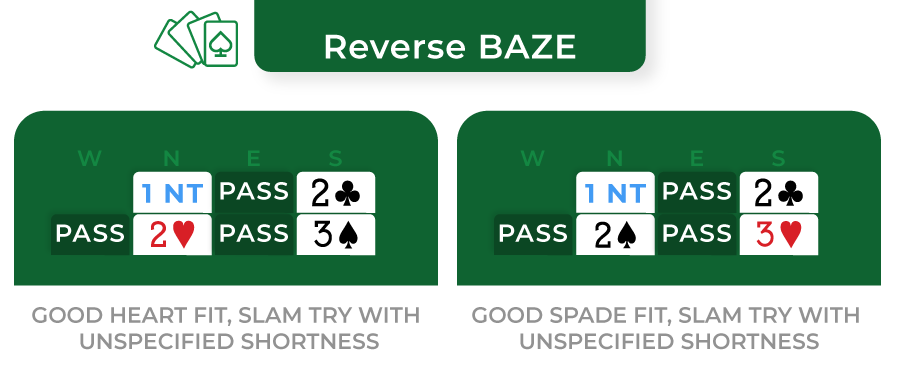
This shows a slam try with a shortness.
Trumps is agreed, as with an 8 card fit and a singleton it’s highly unlikely you’ll still want to play 3nt. Opener just patiently bids 1 step to find out where the singleton is.
Responder then bids his singleton or one under the singleton, whatever agreement your partnership likes to show splinter, direct or 1 under.
Pro tip
I personally like 1 under a bit better as it makes it harder for them to double and sacrifice with a fit and you can use the short suit to ask for A’s and save some space.
Playing my way, these would be the meanings:
1nt - 2c - 2h - 3s - 3nt (ask where is shortness) - ?
- 4c - short diamonds
- 4d - short spades
- 4h - short clubs
1nt - 2c - 2s - 3h - 3s (ask where is shortness) - ?
- 3nt - short clubs
- 4c - short diamonds
- 4d - short hearts
So now the splinter bids are freed up for new meanings.
4d by opener is last train, saying he has something in between and isn’t sure.
He’s say he doesn’t have a bottom or a top and asks responder if he was serious or not serious about the quantitative.
If he’s not serious and was looking for a max responder just signs off in 4 of the major.
If he is serious, he can use 1430 key card or kick back (bidding the suit above trump at the 4 level to ask for key cards (A’s + K of trump, 1 step is 1 or 4 keys, 2 steps is 0 or 3, 3 steps is 2 or 5 without Q, 4 steps is 2 or 5 with queen) or cue bid.
- 1nt - 2c - 2h - 4c Quantitative, 4d now is last train
- 1nt - 2c - 2s - 4c Quantitative, 4d now is last train
After a positive response to stayman 4d is key card for the the major. I like 1430 key card. The 5 key cards are the 4 A’s + the K of trump. 1430 also coincidentally happens to be the score you get for bidding and making a vulnerable game in a major.
After 4d, you bid 1 step to show 1 or 4 keys, 2 steps to show 3 or 0 keys, 3 steps to show 2 (or 5) keys without the Q of trump, 4 steps to show 2 (or 5) keys with the Q of trump.
Bidding past that actually shows a void in the suit bid and odd number of keys or 5nt shows a useful void and even number of keys. But in this situation that’s not possible as 1nt opener can’t have a void.
- 1nt - 2c - 2h - 4d key card for hearts
- 1nt - 2c - 2s - 4d key card for spades
Yes, you do lose some room to cue bid controls, but overall, being able to choose between key card and quantitative is a gain.
Also, If you want to cue bid, just cue bid after hearing the response, normally a new suit at the 3 level is natural and shows the OTHER major, but when you go back to partner’s major he’ll understand it was a cue bid instead.
For example
1nt - 2c- 2s - 3c (normally this shows hearts and clubs) - 3d (maybe natural maybe cue bid) - 3s (but now that you went back and supported him he knows 3c was more likely a cue bid than showing clubs and hearts) so in a sense if you’re clever and your partner is patient you can still cue bid if you so choose.
This works much better with seasoned, creative, players who will try to stall for time and temporize with “fake” bids to sniff for more information.
A fast 4s/4nt without going through the special agreements is quantitative without a fit (see 2 way quantitative above)
The reverse BAZE treatment can also be applied to situations after a transfer:
- 1nt - 2d - 2h - 4c serious quantitative with 6+ hearts, 4d is now last train
- 1nt - 2h - 2s - 4c serious quantitative with 6+ spades, 4d is now last train
Please note
You also have a non-serious slam try by transferring first then bidding 4 of the major (1nt - 2d - 2h - 4h, 1nt - 2h - 2s - 4s, these generally were only interested in slam if opener could supper accept):
- 1nt - 2d - 2h - 4d key card for hearts with 6+ hearts
- 1nt - 2h - 2s - 4d key card for spades with 6+ spades
- 1nt - 2d - 2h - 4s, serious quantitative with 5 hearts
- 1nt - 2h - 2s - 4s, serious quantitative with 5 spades
- 1nt - 2d - 2h - 4nt, non-serious quantitative with 5 hearts
- 1nt - 2h - 2s - 4nt, non-serious quantitative with 5 spades
Muppet is short for modified puppet, there are several versions but what they generally have in common is the 3d response to 3c no longer says anything about a 4 card major.
Oftentimes it makes it harder for defenders to know how many cards declarer holds in the majors.
Like puppet, use muppet whenever your partner opens 1nt and you have a game forcing hand with a 3 card major and can’t transfer to a minor you should use muppet.
EXCEPT (31)(54) hand, then you should jump 3 of the major, or 33(43) hands just jump 3nt (or higher quantitative/Grand slam force/gerber bids with slam going hands) even if you find a 5-3 fit it’s usually better to play in 3nt not 4 of the major with square shape.
With (43)33 shape use puppet only to check for 5 cards in your 4 card major, play 3nt if you find 5 cards in your 3 card major.
Important
Before we delve into how Muppet works exactly, we should be aware that muppet for 1nt - 3c and 2nt - 3c are different.
The reason is when we open 1nt we have the option to use regular staymen, whereas after 2nt we do not. So certain hand types are not possible after 1nt - 3c that are possible with 2nt - 3c.
For example
1nt - 3c, responder can NOT have both 4 card majors as he would’ve kept things on a need-to-know basis and used regular staymen instead.
After 2nt you only have 1 muppet stayman available without going over 3nt so 4-4 in the majors is possible.
Another case is responder using muppet can not have a 4 card major without a 3 cards in the other major.
If responder only cared about 4 card majors he should use regular staymen and not have opener divulge unnecessary extra information. It’s only when responder has a 3 card major that he cares about 5 card majors.
1nt - 3c - ?
- 3d - no 5 card major
- 3h - 5 hearts, may or may not have 4 spades
- 3s - 5 spades, no 4th heart
- 3nt - 5 spades, 4 hearts (5422 exactly)
After 1nt - 3c - 3d - ? Responder bids 4 card majors he does NOT have up the line
- 1nt - 3c - 3d - 3h responder denies 4 hearts but says nothing about spades, over 3h opener bids naturally. 1nt - 3c - 3d - 3h - 3s shows 4 spades, 1nt - 3c - 3d - 3h - 3nt denies 4 spades.
- 1nt - 3c - 3d - 3s shows 4 hearts (the inference is he has 4 hearts and 3 spades, with 4 hearts and 2 or less or 5 or more spades he would’ve taken a different route like regular staymen, or smolen, or delayed texas, see if you can figure out what’s the correct way to bid with each), 1nt opener just bids naturally after that, new suits at the 4 level should be cue bids with a fit in hearts.
- 1nt - 3c - 3d - 3nt shows no 4 card majors (the inference is responder has as AT LEAST one 3 card major as he was interested in at least one 5 card major)
After 1nt - 3c - 3h - ?
- 1nt - 3c - 3h - 3s Asks opener to bid 3nt. Because responder wants opener to declare the contract, by bidding 3s he actually denies 4 spades. Opener is then forced to bid 3nt. If responder keeps bidding it’s a natural long minor and a slam try. If responder wants to cue bid and show a fit for hearts with slam interest he shouldn’t go through 3s and directly cue bid the minors.
- 1nt - 3c - 3h - 3nt Opener by skipping 3s actually shows 4 spades. But because he wouldn’t bid puppet without a 3 card card major he will also have 3 hearts. Responder is asking opener to pick between 4h and 4s here in case opener has 4 spades and 5 hearts it’s better to play in the 4-4 spade fit than the 5-3 heart fit. This can be tricky to remember so only play it with an advanced+ regular partner.
1nt - 3c - 3s and 1nt - 3c - 3nt
These should be pretty self explanatory as opener has almost completely shown his majors. Responder should usually be choosing between 3nt, 4 heart, or 4 spades.
To right-side the contract, responder will transfer opener to a major after 1nt - 3c - 3nt (showing 5 spades, 4 hearts) with 4d transfer to hearts, 4h transfer to spades.
Let’s show a few examples of why muppet is superior to puppet.
- Puppet: 1nt - 3c - 3d - 3nt
- Muppet: 1nt - 3c - 3d - 3nt
In the 1st case, defenders know opener has a 4 card major because 3d in puppet shows a 4 card major,
In the 2nd case, defenders don’t know. Opener may have a 4 card major or he may not, the 3d didn’t tell them.
- Puppet: 1nt - 3c - 3d - 3h - 3nt
- Muppet: 1nt - 3c - 3d - 3h - 3nt
In the 1st case, defenders know responder has 4 spades and 3 hearts because he bids 3h showing 4 spades and he used puppet not regular stayman so he must also have a 3 card major.
They also know opener has 4 hearts because 3d in puppet shows a 4 card major yet did not want to play in 4 spades so his 4 card major must be hearts.
Given this information they will probably try to lead a minor as both players have a 4 card major.
In the 2nd case, defenders know responder has 4 spades and 3 hearts because he bids 3h showing 4 spades and he used muppet not regular stayman so he must also have a 3 card major.
But they have no idea if opener has 4 hearts, because 3d didn’t tell them anything about 4 card majors.
- Puppet: 1nt - 3c - 3d - 3s - 3nt
- Mupet: 1nt - 3c - 3d - 3s - 3nt
In the 1st case, defenders know responder has 4 hearts and 3 spades because he bids 3s showing 4 hearts and he used puppet not regular stayman so he must also have a 3 card major.
They also know opener has 4 spades because 3d in puppet shows a 4 card major yet did not want to play in 4 hearts so his 4 card major must be spades.
Given this information they will probably try to lead a minor as both players have a 4 card major.
In the 2nd case, defenders know responder has 4 hearts and 3 spades because he bids 3s showing 4 hearts and he used muppet not regular stayman so he must also have a 3 card major.
But they have no idea if opener has 4 spades, because 3d didn’t tell them anything about 4 card majors.
After transferring, sometimes you would like to check if partner has 5 cards in the other major when there might not be a fit in the major you transferred to.
Suppose you have: AQ2 KQ1092 432 32

Normally you would bid 2d transfer to hearts then bid 3nt with basic methods. But it would be a shame to miss a 5-3 spade fit when opener had 5 spades but not 3 hearts. Even worse, on a REALLY bad day they cash 5 cards in a minor you didn’t have a stopper in and you go down in 3nt.
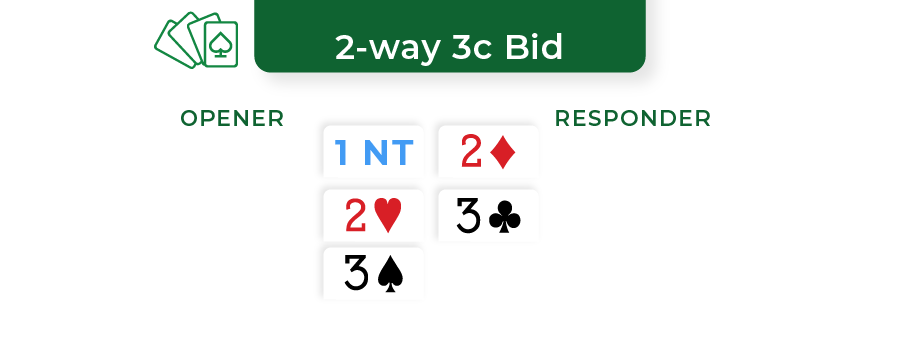
The solution is after a transfer use 3c as either natural clubs and game forcing or checking to see if partner has 5 cards in the other major.
Here’s what 1nt opener should do after completing a transfer and responder bids 3c.
- If you have 3 cards in the suit partner transferred into just bid it, you found a fit no need to be greedy
- If you DON’T have a fit in the suit partner first transferred into bid your own 5 card major if you have one. Example: 1nt - 2d - 2h - 3c - 3s (I have 5 spades but no heart support)
- If you Don’t have a fit in the suit partner first transferred into and you don’t have a 5 card major of your own, bid 3d if you have a good club fit if partner had clubs Example: 1nt - 2h - 2s - 3c - 3d (I don’t have 3 spades, I don’t have 5 hearts, but if you actually had clubs I do have a good club suit with at least Hxxx in clubs)
Failing all 3, bid 3nt, you don’t have a fit for partner’s major, you don’t have a 5 card major of your own, you don’t have a club fit.
Here are some of the advanced bidding systems you will encounter:
Bidding tends to be pretty easy when the opponents don’t bid, you just study hard and remember what agreements you have then use them in the smartest way possible and do some experimenting to see what works and what doesn’t and ask some experts for tips and pointers in situations you’re not sure what to do.
Bidding is a lot more difficult when the opponents start getting in your way. You need to remember a lot more special agreements for all the different interferences. Interferences have special meanings sometimes and you have to figure out on the fly what bid should mean by logic, not what you want them to mean so you and your partner will be on the same page. You also need to use more judgment on when to and not to bid.
Fortunately for 2 level interference vs 1nt I have a very nice refined system you can use.
When the opponents double or bid 2c, just ignore the bid and play “systems on”, pretend they didn’t double and pretend they didn’t bid 2c and double 2c as a “stolen” stayman bid, no exceptions just to keep it simple.
For all the other 2 level interference bids 2d, 2h, 2s use modern transfer Rubensohl
It’s evolved from basic Lebensohl, to transfer Lebensohl, to Rubensohl, to modern transfer Rubensohl for me. Here I will quickly share the basic Lebensohl, not because it’s what I personally recommend, but because it’s very common and many players will play it so it’s useful to know. The difficulty gap in learning the different versions isn’t too great so I will share the final version that I currently prefer and favor.
Basic Lebensohl:
After 1nt (2d/2h/2s) ?
Note bids in () means it’s the opponents who bid it
2 of a major is natural 5+ cards, weak, and “to play”
2nt is the special “lebensohl” bid forcing 1nt opener to bid 3c, if responder then bids a suit lower than opponents suit it’s weak and “to play”, if responder bids a suit higher than the opponents suit it’s invitational
A direct 3 level bid is natural and forcing to game.
If you go through 2nt then bid 3nt you show a stopper in their suit and no 4 card major
If you go through 2nt then cue bid their major (if they bid a major) you show a stopper and 4 cards in the other major
If you directly bid 3nt you deny a stopper in their suit and no 4 card major
If you directly cue bid their major you deny a stopper in their suit and show 4 cards in the other major.
Essentially 2nt shows a stopper, and cue bidding their suit shows 4 cards in the other major. With 5 cards or more and GF just jump 3.
But since this is the advanced section, I’m not here to teach you what’s standard and basic. I’m here to teach what I know to be best. It is still good to know what the basic treatments are so you’ll understand them when your opponents use them, or if you have no time to discuss details with a pick-up partner.
Not so different from basic Lebensohl. The 2 level bids are still natural, weak, and “to play”
The 2nt bid is still a relay to 3c, forcing 1nt opener to bid 3c ALWAYS.
The main differences are:
- The 3 level bids are now transfer bids
- 2nt is now used to show the other major, cue bid is now used to show/deny a stopper.
3 level transfers to a lower suit is weak or strong (weak will pass, strong will bid again and is forcing to game)
3 level transfer to a higher suit is invite or better (opener takes the transfer to reject the invite, or bids something else to accept the invite 3nt is to play new suits are cue bids)
3 level transfer into the opponents suit is a fast cue bid, because you didn’t go through 2nt you deny the other major, because you’re cue bidding their suit via a transfer you deny a stopper.
Bidding 3nt directly denies 4 cards in the other major because you didn’t go through 2nt, it also shows a stopper because you didn’t bother transferring into their suit to cue bid to ask for a stopper.
Going though 2nt forcing 3c then bidding a lower suit is natural and invitational.
Going through 2nt forcing 3c then bidding a higher suit is natural and a slam try.
Going through 2nt then cue bidding their suit denies a stopper and shows 4 cards in the other major.
Going through 2nt then bidding 3nt shows a stopper and shows 4 cards in the other major.
This system gives you more bidding options by taking advantage of transfers and right sides the contract more. The memory difficulty isn’t much harder than playing basic Lebensohl.
Texas transfers are on if 4d is a jump.
Here’s a few practice problems, what would you bid with the following hands, partner opens 1nt and RHO overcalls 2h (natural, or 2 suiter with hearts)
1nt (2h) ?
- KQ432 32 432 432
- 32 32 432 QJ10432
- 32 32 QJ10432 432
- K2 32 KJ10432 K102
- K2 Qxx KJ10432 1092
- KJ102 KJ2 Q1092 Q2
- KJ102 32 Q1092 KQ2
- J2 KJ2 KQ109 Q1092
- Q2 432 KJ102 AKQ32
- KQ1092 32 K32 J102
- KQ10932 2 QJ32 32
- KJ10932 K2 AQ AQ10
Answers:
1. KQ432 32 432 432 - you’re weak but you do have a nice suit, bid 2s to play
2. 32 32 432 QJ10432 - bid 2nt, partner is forced to bid 3c then you pass
3. 32 32 QJ10432 432 - bid 3c, weak or strong diamonds, partner is forced to bid 3d then you pass
4. K2 32 KJ10432 K102 - Here you have a good diamond suit and enough to gamble on game. But you need to know if partner has a heart stopper and if a diamond fit is meaningful. Bid 3c, weak or strong diamonds, then bid 3h telling partner you have enough for game, a good long diamond suit, and you need help with stopping hearts.
5. K2 Qxx KJ10432 1092 - this hand is invitational in strength. First bid 2nt, after partner bids 3c (forced), you bid 3d showing an invite with a long diamond suit
6. KJ102 KJ2 Q1092 Q2 - here you want to show you have 4 spades and a heart stopper. First bid 2nt, which if we cue bid or bid 3nt later will show 4 spades. After partner bids 3c, bid 3nt showing 4 spades (because you first bid 2nt) and a stopper (because you didn’t cue bid 3h)
7. KJ102 32 Q1092 KQ1 - here you want to show you have 4 spades and no heart stopper. First bid 2nt, which if we cue bid or bid 3nt later will show 4 spades. After partner bids 3c, bid 3h showing 4 spades (because you first bid 2nt) and no heart stopper (because you cue bid their suit)
8. J2 KJ2 KQ109 Q1092 - here you just want to play 3nt, so just bid it. You didn’t go through 2nt so you don’t have spades, you didn’t transfer to 3h so you don’t have a problem with heart stopper
9. Q2 432 KJ102 AKQ32 - here you don’t have spades but you need partner to have a heart stopper to play 3nt. Bid 3d, a transfer to their heart suit asking for a heart stopper. You deny 4 spades because you didn’t go through 2nt first.
10. KQ1092 32 K32 J102 - here you want to invite with spades bid 3h transfer to spades. Since spades is a higher suit than hearts it’s invite or better, partner bids 3s with a min (even if he has only 2) and 3nt or 4s with a max, 3nt should have a heart stopper.
11. KQ10932 2 QJ32 32 - here you don’t want to mess around you have great shape but not much slam interest, bid 4h Texas transfer and get it over with.
12. KJ10932 K2 AQ AQ10 - this hand’s interesting, not only do you have a great hand but it’s one of those rare hands where you would rather declare than the 1nt opener declare. Don’t texas transfer than ask for key cards.
Best is to start with 2nt and after partner bids 3c bid 3s, a slam try with spades. This way you get to play the hand and protect your hand from the lead. You want to be a hand hog on this one.
If the opponents interfere at the 3 level, there’s not much room to be fancy I recommend just playing take out doubles, natural and forcing major bids, and non-leaping michaels (4 of a new minor shows a 2 suiter with that minor and an unspecified major, 4 of their minor shows both majors)
Over their 2nt (usually showing the minors) I recommend playing the same systems as if partner opened 2nt, so transfers, puppets stayman for 2nt which we’ll cover in a future article.
Conclusion
There you have it - the complete guide to 1NT bidding in bridge.
While this was a long journey, knowing all the different gadgets and how you can work with them depending on the situation will definitely improve your odds of success.
However, gadgets alone do not guarantee success. It’s not what tools you have, it’s how well you use them.
A strong foundation in bidding principles, effective partnership communication, and disciplined convention usage are vital for bidding success. You can check my other Academy guides to learn more.
The gadgets over 1nt are the least controversial, good gadgets and agreements for 1nt have very few drawbacks. Learn these well, and they will serve you well for a long time to come.
By continuously expanding bidding knowledge, honing skills, and adapting strategies, you can pursue lifelong mastery in the art of 1NT bidding. Every time a 1nt gets opened, you can be excited knowing you have an edge over other players having all the best tools to find the right contract.

Bonuses
Casinos
Games
Academy
News
Shop
NEW Q&A
Sweepstakes






































